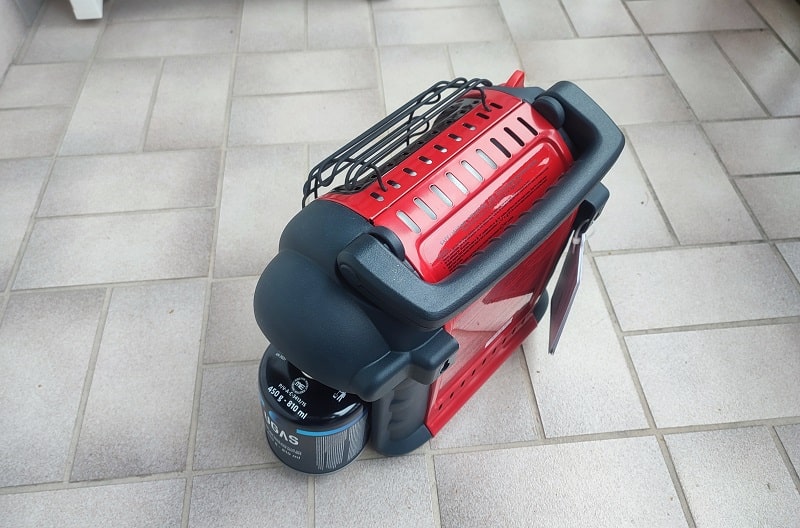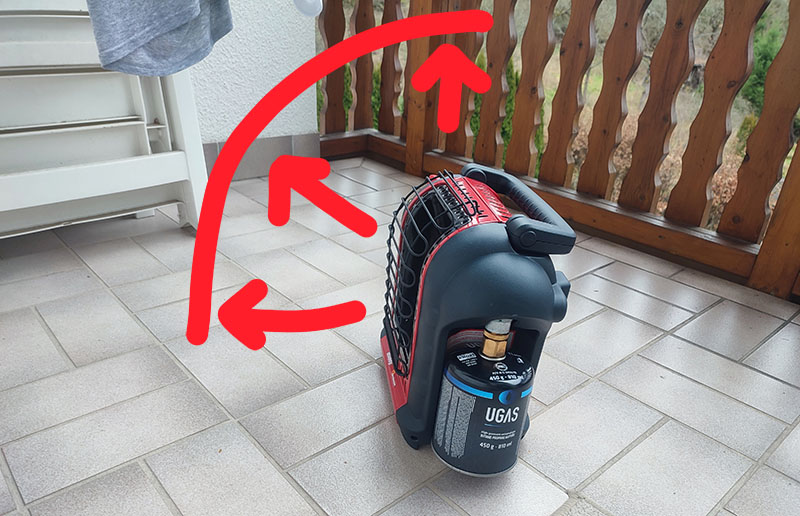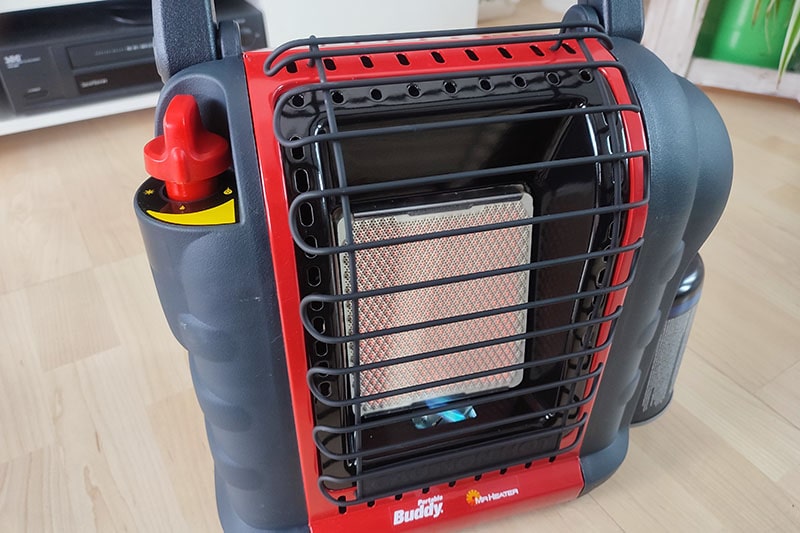Are blue flame or infrared heaters better? The answer is: Blue flame and infrared heaters are almost the same. Together, we’re going to myth bust blue flame and infrared heater differences.
And after reading this article, you know exactly which heater to pick.
Quick answer: Technically, infrared heaters are better than blue flame heaters since they radiate some of the heat into the room. Blue flame heaters emit hot air which rises upward. So, infrared heaters have a slightly better heat distribution. However, practically, blue flame and infrared heaters both produce radiant and convection heat. So, the main difference is looks. Heating output, gas usage, and efficiency are equal.
Together, we are going to test the heat output of my propane heater (which looks like an infrared heater). The surprising result: Gas-based infrared heaters often only look like infrared heaters, but output the heat in a very different way.
So, stick out until the end!
Why blue flame and infrared heaters are almost the same
Blue flame heaters and infrared heaters are very similar. Let’s have a look at how blue flame and infrared heaters try to be unique but fail to do so.
How blue flame heaters work
Blue flame heaters, as the name suggests, emit a visible blue flame. The flame heat the air, which, in turn, rises upward.
So, blue flame heaters are convection heaters. Convection heaters produce hot air. The hot air then mixes with the air in your room, which raises the temperature.
And that’s already the point where most websites stop. Everybody online describes blue flame heaters as pure convection heaters, which is wrong.
Blue flame heaters are not pure convection heaters. After all, there is a visible flame. And in a simplified way, you can say:
Whenever there is light, there is heat.
You can prove this statement using thermodynamics (“All energy (including light) ends as heat”), or by touching a light bulb.
Now, you might argue that light bulbs get hot because of the glowing wire inside. Yes. But the light coming from the light bulb is heat as well.
Think of lasers, for example. Or the sun. Light of whatever color always ends up as heat.
Another example is greenhouses. The light passing through their transparent wall is not infrared, it’s visible sunlight. The sunlight bounces around inside and heats the greenhouse.
In fact, infrared is not hotter than other wavelengths (colors) of radiation.
A blue flame radiates the exact same amount of heat as an equivalent infrared source.
The mental mistake we make is an association error. We subconsciously connect the color red with heat, because red heat is much more present on earth than blue heat.
For example, fire, lava, and glowing metal are all red. There are no natural examples of blue heat on earth.
But on a larger scope, the universe has a lot of alternative-color energy sources. For example, stars emit white or blue(ish) light. Also, burning propane gas (such as in a blue flame heater) is blue.
According to Planck’s law, hot objects emit energy mostly in the infrared spectrum. But the hotter an object is, the bluer the light. Very hot objects radiate ultraviolet.
So:
Blue flame heaters emit some of their heat as radiation and some of their heat as convection.
What is different in infrared heaters?
If blue flame heaters emit radiation and convection, then how do infrared heaters emit their heat?
Basically, a gas-based infrared heater needs a heat source to heat up a ceramic heating tile. The ceramic tile then glows red and emits infrared heat.
But:
Inside an infrared heater, there is a blue flame that heats up the ceramic heating tile. So, a gas-based infrared heater is the same as a blue flame heater. The difference is that a ceramic tile hides the flame.
There is no other technical difference between blue flame heaters and infrared heaters.
They are identical!
So, which effect does the ceramic heating tile hiding the gas flame have?
The heating tile absorbs the energy of the flame. Usually, the ceramic heating tile has a large surface area because it is perforated.
So, the blue-flame heat distributes over the large heating tile surface area, which leaves you with a “cooler” red glow (instead of a hot blue glow).
The tilt of the heating tile and reflectors behind the heating tile help radiate the heat into the room.
The glowing ceramic heating tile increases the amount of heat radiating into the room. Whereas in a blue flame heater, most of the heat rises straight upward as convection.
Still, the overall amount of heat both heaters produce is the same, given they consume the same amount of gas.
The biggest difference between infrared gas heaters and blue flame heaters is the direction of heat. In most cases, heat radiation into the room (instead of upwards) is preferable.

Mythbusting Blue Flame vs Infrared Heaters
Many people (including authors of large HVAC websites) totally misunderstand blue flame and infrared heaters. Or, to be fair, they get the basic points, but accidentally spread misinformation.
I want to make up for this. So, here are 3 myths about blue flame vs infrared heater differences and whether they are really true or not:
“Blue Flame heaters typically work better in insulated areas, while Infrared heaters may work better in un-insulated areas”
Both blue flame and infrared heaters have a fixed heat output. The insulation of the room does not matter at all.
But you can direct the heat better with infrared heaters. So, infrared heaters are indeed more practical for uninsulated rooms.
But in insulated rooms, both heaters are the same.
“Blue Flame heaters may take longer to heat the room […], while Infrared heaters provide instant warmth […] to objects in its line of sight.”
That’s also wrong. You can prove this by lighting a lighter. There’s a flame. And a flame is hot instantly. Otherwise, the flame would not be a flame. Flames are ionized gas, which is, by definition, hot.
So, wherever there are flames, there is heat. Both blue flame and infrared heater get hot instantly. There’s no significant difference in heating speed.
I’d even claim that blue flame heaters heat up faster since you can instantly feel hot air rising from the heater.
Infrared heaters, on the other hand, need to heat up a ceramic heating tile and get it glowing hot. This takes a few seconds or up to a minute.
“[Blue flame heaters] do not project the heat outward as much as Infrared heaters do”
Of course, blue flame heaters do not “project heat outward” if you measure only the heat in front of the heater.
Blue flame heaters emit their heat mostly upward. And they produce a lot of heat quickly. This is just another plain wrong statement.
It is equal to claiming that infrared heaters don’t project heat upward. The statement itself is true. But it masks the fact that the heat just goes in another direction.
Both heaters produce the same amount of heat.
Case study: Is the Mr. Heater Buddy a blue flame or infrared heater?
In this case study I want to show you why the distinction between the blue flame and infrared heaters is a bit unnecessary.
I have a Mr. Heater Buddy heater. It is a portable propane heater with a ceramic heating tile.
When you turn on the heater, you immediately see flames coming out of the perforated ceramic heating tile.
And after a minute of heating, the Mr. Heater Buddy starts glowing like an infrared heater.
Most portable propane heaters work like this.
They are a combination of flame heat and glowing heating tile radiant heat.
So, are they infrared heaters or blue flame heaters now?
You can’t clearly tell. On one side, there is a blue flame after turning it on, which vanishes (or becomes invisible) when the ceramic heating tile glows.
The Mr. Heater Buddy looks a lot like an infrared heater. But the majority of the heat leaves the heater up through the air vents.
However, the heater also radiates some of the heat into the room from the glowing hot ceramic tile.
So, you can’t really distinguish between a blue flame and an infrared heater in this case.
Most propane heaters are a mix of blue flame and infrared heater. They are interlinked.
You can’t get blue flame without infrared and vice versa.
If you buy a blue flame heater, some of the heat will radiate as infrared. And if you get an infrared heater, you need a blue flame to heat up the infrared heating element.
Only the ratio of convection and radiation heat varies between heaters. But you always get a mix of both worlds, and never only one.

Should you pick a blue flame or an infrared heater?
Which one is better now? Blue flame or infrared?
There is absolutely no technically relevant difference between blue flame and infrared heaters. In real heaters, you can’t even distinguish blue flame and infrared heaters clearly.
Yes, some heaters expose the blue flame, which makes you call them “blue flame heaters”. And some heaters expose an infrared heating element, which makes you call them “infrared heaters”.
But this is just name-calling. And technically, both heaters deliver a mix of infrared and convection heat.
It does not matter whether you get a blue flame or infrared heater. It is more of a design preference.
Do you prefer the look of a blue flame or the look of a glowing red hot heating element?
I prefer the glowing look, so I picked an infrared propane heater.
Recommended infrared propane heater
My favorite infrared propane heater is this Mr. Heater Buddy heater (click here to view it on amazon).
It provides a lot of heat, feels sturdy and you can carry it everywhere. You can use it to heat your garage, workshop, RV, or also your living room, or bedroom.
Of course, Mr. Heater heaters have an outdoor-ish look.
So, I recommend getting one for supplemental heat around and in your house. But I would not choose it as a primary heat source for my living room or bedroom.
For that, I’d prefer a better-looking blue flame heater.
Recommended blue flame heater
Blue flame heaters are more stylish. This Dyna Glo blue-flame heater (click here to view it on amazon) is wall-mounted.
So, it is perfect for indoor heating. Children or pets can’t tip over the heater. And it looks great.
It requires a little installation work for the wall mounting. But it’s no harder than installing any other wall-mounted things. You don’t need to install any ducts with this heater, since it is vent free.
Of course, the Dyna Glo blue flame heater is not good for portable heating. But if you need to heat just one space, then it’s a great choice.
You can’t go wrong with it.
Conclusion
Blue flame and infrared heaters are very similar. They don’t differ in heat output, propane usage, efficiency, or any other metric.
Usually, blue-flame heaters are a bit more pricey. But that’s because they are mostly wall-mounted permanent heaters, whereas many infrared propane heaters are portable (and therefore smaller).
Technically, blue flame and infrared heaters are hard to distinguish. Both infrared and blue flame heaters emit a part of their heat as infrared radiation and the remaining part of heat as convection heat.
The only difference is the ratio. Blue flame heaters emit most heat as convection heat, which is just hot air. And infrared heaters emit most of their heat as infrared radiation.
I am not even sure if that is even true. My “infrared” Mr. Heater Buddy looks like an infrared heater. But most heat is hot air going up through the air vents.
Probably you can even say that most propane (or other gas) heaters are mostly convection heaters.
In the end, the kind of heat emission does not matter.

